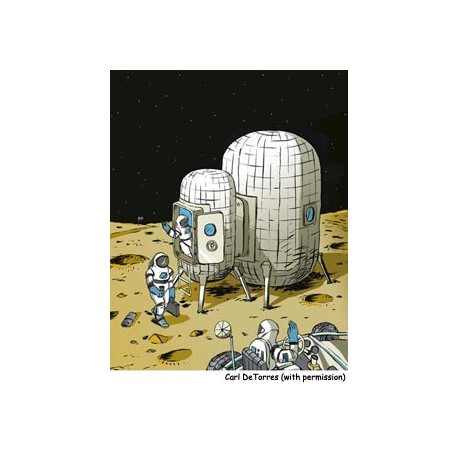 View larger
View larger
Build a Moon Habitat
New activity
Astronauts on the Moon must have homes that protect them like no home on Earth would ever need to do. Teams of participants roll sheets of newspaper to create "logs," which are stapled together to frame a "habitat" and "airlock." The structure is covered with a bedsheet and decorated with the NASA logo.
Open Activity
-
Rating
-
Participants Enjoyed the ActivityParticipants Learned from This ActivityActivity Instructions Were Clear and Easy to FollowWould Recommend
Related Programming Resources
| Related Links |
Websites:
Globus, Al (May 07, 2016). “Space Settlement Basics.” Will We Ever Colonize Mars? Last Mission to the Moon Apollo 11 in Real Time Video Clips: European Space Agency Video: Building a Moon Base • NOVA video: Extreme Temperatures on the Moon NASA videos: A Day in the Life Aboard the International Space Station Images: Pat Rawlings Space Art Some images follow the NASA media usage guidelines and may be used for educational or informational purposes. Please note the copyright status of the specific image of interest. Slideshows: • Understanding Martian Resources and Environmental Constraints |
| Originating Source | NASA Space Place |
| Related Books [Suggest a book] |
Science Adventures with Max the Dog by Jeffrey O Bennett and Michael W Carroll
Moon Base Alpha Series by Stuart Gibbs Packing for Mars: The Curious Science of Life in the Void by Mary Roach Astronomy: Cool women in space by Anita Yasuda and Lena Chandhok |
Reviews
All the best space puns apply!
Have you ever tried to make a lunar habitat out of newspaper logs with a bunch of kids? You haven’t lived until you do! Also, please note: someone, at some point, WILL point out that newspaper isn’t a suitable material for lunar habitat design and insulation.
In all seriousness, this activity was a bundle of crazy fun! We filled our entire large meeting room with habitat components (living quarters, laboratory, communications center, Jedi training complex) before our two-hour Monday Makerspace event came to a close. Actually, we’d filled it up long before then, and spent the majority of the final hour staging lunar coups and discussing micrometeorite impacts and best practices for Helium-3 mining. These were five to twelve-year-olds, and they were serious about their engineering. Luckily, I’ve read a fair bit of Kim Stanley Robinson, Andy Weir, and Ian McDonald lately. I’m hip to the in situ offworld colony engineering thing (fictionally, anyway).
A couple of suggestions:
- After demonstrating the best newspaper-rolling techniques, I recommend supplementing with other materials. We had some large cardboard boxes left over from our last CSLP shipment, and these helped build corridors and stiffen some existing structures. We also had a bunch of Mylar sheets leftover from a previous program (you can buy them super cheap in the form of emergency camping blankets), and this material proved to be most beloved of all amongst our lunar engineers. We spent some time discussing the tensile strength and insulating properties of Mylar (BoPET), as well as its use in real-world offworld science projects, including NASA’s space suits.
- If you introduce cardboard into the mix, you’ll need (supervised!) X-ACTO blades or some other means of cutting through without harming little fingers. If you introduce Mylar or something similar, you’ll need scissors. I highly recommend bringing along glue and spare construction or wrapping paper, markers, and other materials for decoration. Just because you’re on the Moon doesn’t mean you can’t upgrade your design with a bit of flair!
- Tape is vital. Lots and lots of tape. Several *kinds* of tape. Newspaper doesn’t respond well to some kinds of tape, however (especially masking tape) so this might provide another moment of instructional opportunity as you discuss tools and material science with your kiddos, as well as economics. Duct tape costs a lot more than packing tape, and it is far more “costly” in terms of weight when lifting materials offworld, but it has better tensile strength, and for now at least it’s pretty much impossible to manufacture plastics on the lunar surface. At what point might a lunar colony think that better materials will be worth the expense? If kids can re-enact “The Last Jedi” with nothing but rolled-up newspaper lightsabers, they’re 100% ready and equipped to take a stab at answering questions like these. As long as they’re having fun, of course!
- We did not make the moon cookies. We did not have the time, and we also have some severe peanut, lactose, and gluten allergies/intolerances. With a bit of experimentation, it should be possible to alter the recipe to suit. We hope to do that in the future and will update our review if we do.
- Be prepared for the inevitable drama as kids beg their parents to somehow jam their habitat structures into the trunks of their vehicles. Demonstrating the break-down (and pack-flat) process with one structure for all of the kids at once will resolve much of the chaos and convince many parents that you are not, in fact, attempting to crowd them out of their own cars. We also had a fair amount of pristine (unused) materials on hand to give out at the end for kids to take home and continue building at home, and almost every family took some.
All in all, the “Build a Moon Habitat” activity requires only that you hang on to last week’s newspapers (at a library of our size, one week’s worth of free local papers proved about perfect) and bring out any leftover recyclables you might have secreted away in various nooks and crannies. And the tape. It takes a fair amount of engagement and explanation to bring the kids on board in the beginning, but once the engineering fever takes hold, this activity has legs.



